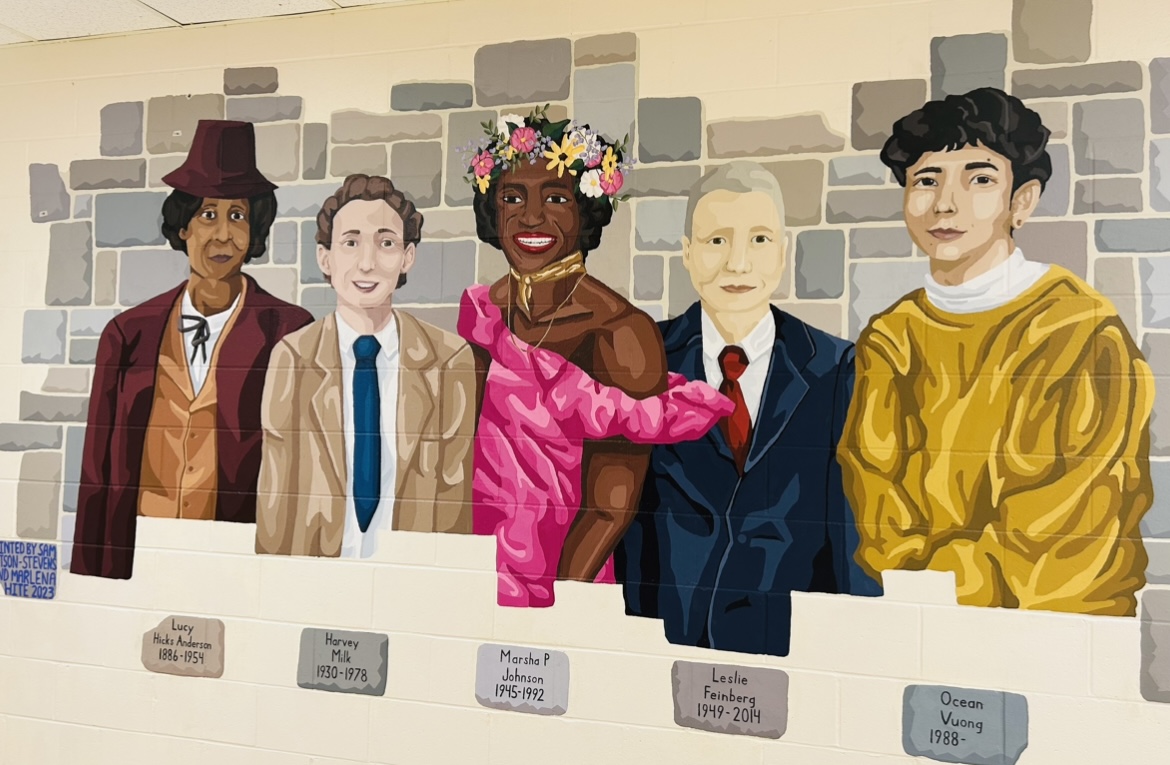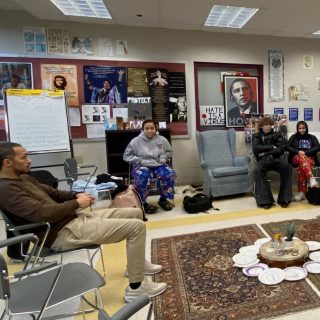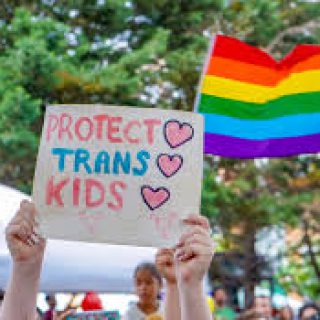Student-created LGBTQ mural at ARHS highlights important activists who changed history

Activism can be viewed and expressed through many different lenses and mediums. But art has been shown to be one of the more diverse and flexible ways to push for social change, sometimes simply raising awareness through exposure to images or ideas.
ARHS seniors Sam Watson-Stevens and Marlena Hite decided to take advantage of the power of art and worked all year long on a large painted mural exhibiting five prominent LGBTQ figures. The painting is on a wall across from an all-gender bathroom in the tech hallway.
The mural includes Black trans woman Lucy Hicks Anderson, a “socialite, chef, and prohibition-era entrepreneur” from Kentucky born in the 1800s; the first openly gay man to be elected to public office in California, Harvey Milk, who was also white and Jewish; Black trans activist Marsha P. ( for “Pay It No Mind”) Johnson–described as a “gay liberation activist and self-identified drag queen” who took part in the Stonewall Riots and fought for the rights of marginalized and homeless queer youth; Leslie Feinberg, a white, Jewish, working class, communist/anti-racist butch lesbian and transgender activist–and author of Stone Butch Blues; and finally, Vietnamese American poet, essayist, and novelist Ocean Vuong (known for his books On Earth We’re Briefly Gorgeous, Time is a Mother, and Night Sky With Exit Wounds).
Vuong, whose first novel is taught in LGBTQ Literature at ARHS, lives in Florence, Massachusetts, and is the only living queer person in the mural. Johnson’s body was found in the Hudson River in July 1992 and her death was ruled a suicide by the New York Police Department but a film called The Death and Life of Marsha P Johnson, released in 2017, addresses the belief by her close friends and family that she was murdered. Many continue to push to find justice for Johnson.
Hite and Watson-Stevens were inspired to construct the mural after taking LGBTQ Literature in their junior year with English teacher Amanda Lewis.
When it came to actually choosing who they would display in the mural, they found themselves faced with a plethora of complex and difficult criteria. On one hand, both Hite and Watson-Stevens strongly reinforced the importance of acknowledging the racial, religious, and gender diversity in the queer community when selecting the five figures. They also wanted to include a mix of activists, artist, and writers.
Hite and Watson-Stevens also thoroughly researched each figure to avoid choosing someone who may have had a problematic past that could cause unwanted attention or criticism.
When deciding to construct the mural, Watson-Stevens and Hite approached Art Department Head Jeff Stauder and proposed that he take them on in an ALP or Alternative Learning Program, where students can pursue projects of personal interest for credit.
When Hite and Watson-Stevens started to construct the early stages of the mural, they quickly found out that the paint supplied by the school’s art department was not up to standards with the updated fire code regulations. They bought new acrylic paint that they say was of higher quality.
However, they did spend an unexpectedly long time “color-mixing” the paints in order to achieve the desired colors especially to produce accurate skin tones.
The original plan was for the ALP to only last three quarters, but construction went into a fourth quarter. “We also used plus blocks to finish,” said Watson-Stevens.
Hite and Watson-Stevens sought out two different grants from the ARPS Parent Guardian Organization to help fund the materials.
The mural is accompanied by a plaque that reads, “Queer and trans people have always been a part of society. They have created and brought together communities for centuries. They have fought for the right to love whomever they choose and to protect themselves from violence and hate. They have written literature sharing their stories, ideas, and knowledge with the world. Queer and trans people have historically been overlooked and the target of discrimination. They have worked in solidarity with others for the liberation of all people. Queer people of color, in particular, have advocated for the most marginalized groups. Queer and trans people have been repeatedly put down but will never stop fighting. Know their stories.”
The reaction to the mural so far has been consistently positive, with some passers-by stopping to ask about lesser-known figures or to simply offer praise to the artists.
Hite and Watson-Stevens had previously been commissioned to construct a mural over the summer, and plan to both keep pursuing art as a hobby after graduation. “It helped us develop hands-on experience and learn how to plan the execution of large projects,” said Hite.
On June 1, Hite and Watson-Steven were honored in a hallway celebration of their mural. Stauder praised them for their tireless work on “the design, funding, and painting of a mural that celebrates pioneers of the LGBTQ+ rights movement” and Principal Talib Sadiq encouraged students and staff to stop by and see their powerful, long-lasting contribution to ARHS.














